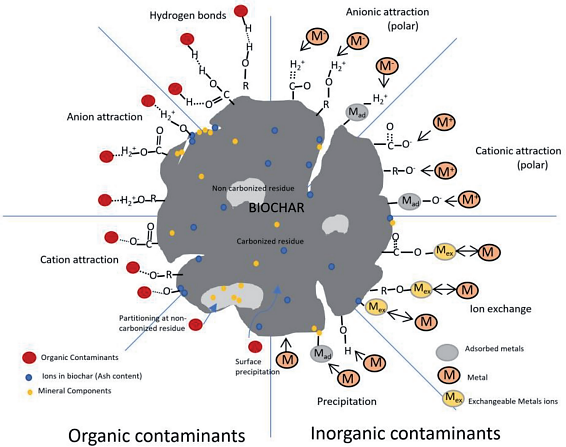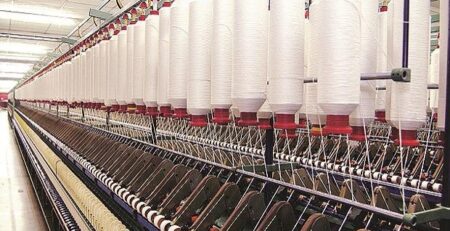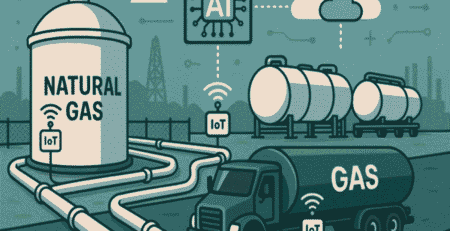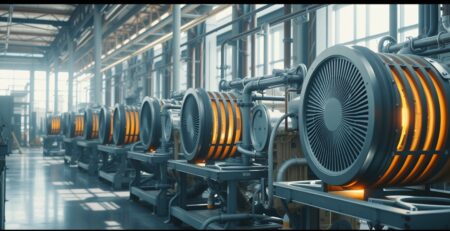Biochar Based Sustainable Water Treatment Technology
Biochar is a stable form of soil carbon with a naturally porous structure that improves aeration, water holding capacity, and nutrient retention of soils and serves as a haven for beneficial soil microbiology, which is the building block of resilient clay. It is a charcoal-like substance made by burning organic matter from agricultural and forestry waste in a controlled process called pyrolysis.
Despite the fact it looks like ordinary charcoal, biochar is produced using a specific process to reduce pollution and store carbon safely. During the process, organic matter, such as wood chips, leaf litter, or dead plants, is burned in a container with very little oxygen. When materials burn, they release little or no contaminant fumes. During the pyrolysis process, organic matter is converted into biochar, a stable form of carbon that cannot easily getaway into the atmosphere. The energy or heat generated during pyrolysis can be captured and used as clean energy. Biochar is far more efficient at converting carbon into a stable form and is cleaner than other forms of charcoal.
 Properties of Biochar for Wastewater Treatment:
Properties of Biochar for Wastewater Treatment:
Biochar is a carbon-rich solid that is produced from biomass through a thermochemical process called pyrolysis. During pyrolysis, the lignin, cellulose, hemicellulose, fat, and starch in the feedstock are thermally broken down forming three products: biochar, bio-oil, and non-condensable gases. Bio-oils and gases can be captured to produce energy and feed depending on valuable by-products such as wood preservatives, food flavorings, adhesives, or biochemical compounds. The yield of biochar and properties however depends on the pyrolysis conditions. The slow pyrolysis and the slow heating rate at moderate temperatures between 350–500 °C results in the production of about 30% biochar with rapid pyrolysis or gasification, compared to a yield of about 10% or less. The feedstock type and pyrolysis conditions used during the production of biochar alter physicochemical properties such as surface area, polarity, atomic ratio, pH, and elemental composition. The efficiency of biochar for wastewater recovery, in effluent recycling plants or wastewater treatment is determined by these qualities.
Biochar is composed of both positively and negatively charged surfaces. The negatively charged functional groups contribute to the cation exchange potential while the anion exchange potential is exhibited by O-containing functional groups (oxonium heterocycles) in biochar. Oxygen-containing alcohol, carbonyl, and carboxylate functional groups are generally believed to contribute to the biochar cation exchange potential because they carry a negative charge and serve as Lewis bases for the adsorption of cations. Whereas, it is believed that oxonium functional groups contribute to pH-independent anion exchange and that both the pyridine functional group and non-specific proton adsorption by condensed aromatic rings contribute to the pH-dependent anion exchange capacity in biochar.
Role of Biochar in Wastewater Treatment:
Biochar can be used at various stages of wastewater treatment or effluent recycling systems, to improve treatment efficiency and recover value-added by-products. Biochar in wastewater treatment can be controlled by mechanisms of adsorption, buffering, and immobilization of microbial cells. If used on treated effluents or in effluent treatment plants, suitably modified biochar can efficiently absorb nutrients such as nitrogen and phosphorus, which can then be used as a nutrient-rich material for soil remediation. When used in the activated sludge treatment process, biochar can play a role in improving treatment and sludge disposal ability by providing a surface for the adsorption of inhibitors and toxic compounds or the immobilization of microbes. Adding biochar to a biological system can ultimately help to improve the soil amendment properties of biosolids. The below will cover the role of biochar for various uses in the wastewater treatment plant.

Organic Pollutants
Biochar produced at high pyrolysis temperatures is found to be better for the removal of non-polar organic compounds due to the high surface area and porosity. In contrast, biochar produced at temperatures below 500 °C has more O- and H-containing functional groups. Thus, they are likely to have a high affinity for polar organic compounds. On the other hand, removal of polar insecticides and herbicides such as 1-naphthol, norflurazone, and fluoridone was observed with biochar produced at temperatures below 300 °C, due to the interaction of the pollutant and the functional groups of biochar. Similarly, higher adsorption of aromatic cationic dyes such as methyl-violet and methyl-blue was observed with biochar which had more O– and H– functional groups but the mechanism was highly dependent on pH. The adsorption of the polar antibiotic sulfamethazine by hardwood/softwood-derived biochar has a pH-dependent interaction. It can be said that pH is the most important factor for biochar interactions and the removal of polar organic pollutants.

Inorganic Pollutant Removal:
Inorganic pollutants in wastewater include heavy metals and compounds such as nitrates, nitrites, ammonium, phosphorus, and hydrogen sulfide that pose significant risks to public health and the environment. Biochar produced at low pyrolysis temperatures has properties that are better suited for the removal of inorganic compounds. The chemical composition and morphological composition play an important role in the adsorption nature of biochar.
Activated Sludge Treatment:
One of the most used systems to treat municipal wastewater is a biological treatment process such as an activated sludge system (ASS) because of its cost-effectiveness and comparatively more simple operation for advanced systems. The activated sludge process is a suspended growth treatment where aerobic microorganisms decompose organic matter in wastewater, which eventually settles as a solid by gravity. Currently, increasing concerns are being raised about the presence of various microscopic contaminants from pharmaceuticals, personal care products, insecticides, disinfectants, and antiseptics in domestic and municipal wastewater. These pollutants are foreign to the biota in the system, and conventional treatment processes often lead to insufficient removal of these compounds.
Accordingly, discharge requirements are currently being tightened to protect received water from potential contamination and public health hazards. Several modifications and changes have been made to the activated sludge system to address the problem. One such method is activated sludge with powdered activated carbon treatment where powdered activated carbon is added to the aeration basin of the activated sludge system. The large surface area of carbon provides various benefits including adsorption of toxic substances such as pharmaceuticals and industrial chemicals, stabilization of bacteria, and increased sedimentation of activated sludge. However, such a system requires a constant makeup of fresh carbon.
Despite the benefits, the high cost of activated carbon limits its use in municipal wastewater treatment. Biochar may be a low-cost alternative to activated carbon, but its properties are less known. Adding biochar to a biological treatment system, such as within an aeration tank, can increase process stability by (a) adsorption of inhibitors, (b) increasing the buffering capacity of the system, and (c) stabilization of microbial cells.
Anaerobic Digestion:
In the case of anaerobic digestion, an increase in the rate and quantity of biogas production has been observed with the addition of biochar. This is responsible for the buffering properties of biochar, promoting methanogenesis for higher biogas yield. Several studies have suggested an increase in microbial metabolism and growth due to the support provided by biochar. Biochar may also play an important role in reducing the mobility or availability of inhibitors such as heavy metals, pesticides, antibiotics, and other organic compounds by binding them to their porous structure and maintaining proper microbial activity for the digestion process. Furthermore, the adsorption of nutrients in biochar and its slow release increase the availability of nutrients in the soil, while preventing leaching to surrounding water bodies, as is prevalent in the case of biosolids. Therefore, adding biochar to the biological system may ultimately help to improve the soil amendment properties of the biosolid.
Advantages
- It is easy to implement and due to its water-holding properties, it means less maintenance of plants, crops, and lawns. This will save a little on the water bill.
- One tonne of biochar in the ground is equivalent to three tonnes of carbon dioxide permanently removed from the atmosphere.
- Enriched biochar is proven to promote the health and vitality of almost every type of plant, and healthy plants are stronger and more productive.
- Biochar is so high in carbon content that it doesn’t break down over time, which means one application is all you need to improve your soil permanently.
- BioChar could potentially repair soil that has been contaminated with toxic heavy metals. Its large surface area and spongy nature mean it can adsorb metals and other contaminants.
- Biochar can help reduce water and nutrient loss by increasing water-holding capacity. Minimizing nutrient losses through leaching can improve grower profits and sustainability by increasing fertilizer use efficiency, reducing fertilizer costs, and avoiding the need for the enforcement of water-quality regulations for nonpoint source pollution.
Limitations
- Biochar in soil reduces the activity of insects which is necessary for soil growth.
- Biochar increases agricultural production, but it absorbs nutrients leading to a lack of nutrients available to growing plants.
- Repeated use of biochar leads to soil compaction which in turn reduces the yield of the crop.
- Biochar also affects the application of pesticides thereby reducing the efficiency of pesticides in the soil.
- The use of biochar can lead to soil erosion, making the soil vulnerable to harsh climates.
Environmental Concerns:
Biochar seems like a simple material, but it can be the solution to many global problems. Biochar and bioenergy co-generation could help to tackle many environmental problems like climate change by switching fossil fuel use and sequestering the carbon unstable soil carbon pools. It reduces emissions of nitrous oxide. The carbon in biochar counters the degradation and can hold carbon in the soil for hundreds to thousands of years. Biochar is produced during the pyrolysis process which heats the biomass in the absence of oxygen. During the production of biochar, clean and renewable energy is generated as a by-product and can be used as an alternative to burning fossil fuels, which have increased global warming by adding greenhouse gases to the atmosphere. When biochar is buried in the soil as a soil enhancer, the system can become “carbon negative”. Many environmental benefits of biochar include are written as below.
- It reduces groundwater pollution, lower the cost of water filtration, decreases the amount of waste, and higher profitability for farmers. The technology also contributes to food security in drought-prone areas by increasing crop yields and retaining water.
- This system neither pollutes nor degrades water resources; and promotes the efficient use of water reservoirs in crop production and respects customary water resource rights, where applicable.
- It should be drawn to reduce atmospheric carbon to create and increase stable soil carbon sinks, reduce GHG emissions associated with decomposition and combustion of biomass residues, and offset fossil fuel use through bio energy production.
- It should give priority to the use of biomass residues for bio char production.
- It must be characterized to identify properties to demonstrate carbon stability and to match bio characters for complementary cropping systems.
- It should promote above- and downstream biodiversity by enhancing ecological conditions for biodiversity at the local and landscape level and bio char systems must avoid the conversion of native ecosystems and high conservation-value habitats.

Applications:
- It enhances the soil structure.
- It reduces nitrous oxide emissions.
- It decreases acidity.
- It Increases water retention.
- It improves microbial properties.
- It improves porosity.
- It regulates nitrogen leaching.
- Improving electrical conductivity.
- It helps to reduce the ammonia losses, bulk density, and odour.
Biochar Based Sustainable Frequently Asked Questions
1) How is biochar used for water treatment?
Multiple organic, inorganic, and microbiological pollutants are successfully removed by biochar. In contrast to nutrient-rich charcoal, pyrolysis provides clean energy. The use of biochar technology converts circular loops from linear material fluxes. In general, biochar water treatment is a potentially affordable and environmentally friendly method.
2) How does biochar improve water quality?
By eliminating nutrients from water bodies, biochar enhances the quality of the water. Biochar can be put in floating devices like balls, cages, or bags/socks, which are then attached to the ground near the water’s edge and in strategic places like where an inlet empties into a lake.
3) What are the properties of biochar?
Higher surface area and porosity, low bulk density, higher cation exchange capacity (CEC), neutral to high pH, and higher carbon content are some of the crucial physicochemical characteristics of biochar.
4) What is activated sludge treatment process?
A biological floc made up of bacteria and protozoa is used in the activated sludge process, a form of biological wastewater treatment method, to treat sewage or industrial wastewaters.
5) Is biochar harmful to the environment?
Different environmental dangers related to soil, water, and atmosphere are associated with biochar. The Eco toxicity of biochar depends on the feedstocks, the manufacturing process, and the application. Potential environmental problems are associated with the hazardous components in biochar. There may be environmental problems associated with the shape and composition of biochar.










